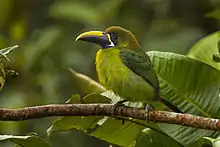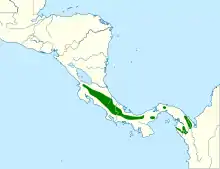Blue-throated toucanet
The blue-throated toucanet (Aulacorhynchus caeruleogularis) is a near-passerine bird living in the mountain forests of Costa Rica, Panama and far northwestern Colombia. While considered a species based primarily on morphology,[2] some authorities continue to consider it a subspecies of the emerald toucanet.[3][4]
| Blue-throated toucanet | |
|---|---|
 | |
| Scientific classification | |
| Kingdom: | Animalia |
| Phylum: | Chordata |
| Class: | Aves |
| Order: | Piciformes |
| Family: | Ramphastidae |
| Genus: | Aulacorhynchus |
| Species: | A. caeruleogularis |
| Binomial name | |
| Aulacorhynchus caeruleogularis Gould, 1853 | |
| Subspecies | |
|
See text | |
 | |
| Synonyms | |
| |
Taxonomy and systematics
The name blue-throated toucanet is also used as an alternate name for the blue-banded toucanet. Although not accepted by some authorities, the blue-throated toucanet was split from the emerald toucanet to form a separate species.[5] The violet-throated toucanet was formerly considered as a separate species (A. cognatus) until lumped as a subspecies of the blue-throated toucanet in 2016.[6] A potential problem relates to the distribution limit between A. c. cognatus and A. c. caeruleogularis in Panama. Although the reason for this treatment is unclear, the population in central Panama has been placed in A. c. caeruleogularis, which limits A. c. cognatus to extreme eastern Panama and adjacent Colombia.[7][8] However, according to George Angehr, author of The Birds of Panama,[9] it is possible that toucanets from central Panama actually are closer to A. c. cognatus.[10]
Subspecies
Two subspecies are recognized:[11]
- A. c. caeruleogularis - Gould, 1853: Found in Costa Rica and western Panama
- Violet-throated toucanet (A. c. cognatus) - Nelson, 1912: Other names used include Nelson's toucanet and Goldman's blue-throated toucanet. Formerly considered as a separate species. Found in eastern Panama and north-western Colombia
Description
Adult
As in all toucans, the blue-throated toucanet has a large bill. The bill is black with yellow to the upper mandible, and a white band at the base, but, uniquely among the emerald toucanet group, with a rufous patch near the base of the upper mandible. Its breast and the rest of its body is mostly light and dark shades of green, except for the throat, which is blue, and the tail-tip and crissum (the undertail coverts surrounding the cloaca), which are rufous. Both sexes look very alike, but females generally have a smaller bill and overall are smaller in appearance, these bird are born blind and naked.
Immature
Blue-throated toucanets are altricial. They do not open their eyes until they are around 25 days old, and they are completely covered in feathers by around 35 days. Most immature blue-throated toucanets do not leave their nest until they have reached around 45 days old. When they leave their nest, their bills are alike to their parents in colour and shape, but are not full-grown yet.
Distribution and habitat
The blue-throated toucanets live in humid mountain forests in Costa Rica and western Panama. Its natural elevation range is from 2,500 ft (762 m) to 7,600 ft (2,316 m) above sea level and it is generally common within its range.
Behaviour and ecology
Breeding
This toucan nests in old woodpecker holes. The nests can be up to 70 ft (21 m) above the ground. Each nest contains 2–4 eggs, white in colour. The eggs have about a 15-day incubation period.
References
- BirdLife International (2014). "Aulacorhynchus caeruleogularis". IUCN Red List of Threatened Species. 2014. Retrieved 2 November 2016.CS1 maint: ref=harv (link)
- Navarro, A.; Peterson, A.; López-Medrano, E. & Benítez-Díaz, H. (2001). "Species limits in Mesoamerican Aulocorhynchus Toucanets". The Wilson Bulletin. 113 (4): 363–372. doi:10.1676/0043-5643(2001)113[0363:SLIMAT]2.0.CO;2.
- American Ornithologists' Union. 1998. The AOU Checklist of North American Birds. 7th edition w. supplements. ISBN 1-891276-00-X
- Dickinson, E. 2003. The Howard and Moore Complete Checklist of the Birds of the World. Christopher Helm. ISBN 0-7136-6536-X
- "Aulacorhynchus caeruleogularis - Avibase". avibase.bsc-eoc.org. Retrieved 2016-11-02.
- "Species Updates « IOC World Bird List". www.worldbirdnames.org. Retrieved 2016-11-02.
- Bonaccorso, Elisa; Guayasamin, Juan M.; Peterson, A. Townsend; Navarro-Sigüenza, Adolfo G. (2011-07-01). "Molecular phylogeny and systematics of Neotropical toucanets in the genus Aulacorhynchus (Aves, Ramphastidae)". Zoologica Scripta. 40 (4): 336–349. doi:10.1111/j.1463-6409.2011.00475.x. ISSN 1463-6409.
- Puebla-Olivares, Fernando; Bonaccorso, Elisa; De Los Monteros, Alejandro Espinosa; Omland, Kevin E.; Llorente-Bousquets, Jorge E.; Peterson, A. Townsend; Navarro-Sigüenza, Adolfo G. (2008-01-01). "Speciation in the Emerald Toucanet (Aulacorhynchus Prasinus) Complex". The Auk. 125 (1): 39–50. doi:10.1525/auk.2008.125.1.39. hdl:1808/6564. ISSN 0004-8038.
- Angehr, G.; Dean, R. (2011). The Birds of Panama. Zona Tropical Publications,Comstock Publishing Associates. ISBN 978-0-8014-7674-7.
- Miller, M. (2009). "Just Back from the 127th Annual Meeting of the AOU". neo-ornithology.blogspot.ca. Retrieved 25 May 2011.
- "IOC World Bird List 6.4". IOC World Bird List Datasets. doi:10.14344/ioc.ml.6.4.
- Skutch, A. F. (1944). "Life History of the Blue-throated Toucanet" (PDF). Wilson Bulletin. 56 (3): 133–151.
Further reading
- Skutch, Alexander F. (1967). "Blue-throated toucanet". Life Histories of Central American Highland Birds. Publications of the Nuttall Ornithological Club: Number 7. Cambridge, Massachusetts: Nuttall Ornithological Club. pp. 51–59. Adds information not present in his 1944 article.
